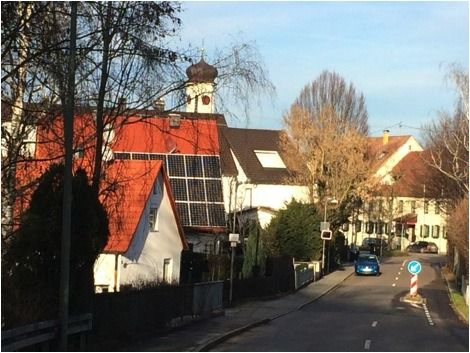Can Germany’s renewable energy revolution be replicated in the United States?
By Beate Liepert | February 18, 2016

When one thinks about solar energy, the first image that comes to mind may be a Californian field of photovoltaic panels. But cloudy Germany, not sunny California, has the advantage when it comes to solar electricity, with a capacity of 38 gigawatts compared to a mere 11 in the Golden State as of 2015. As governments worldwide set ambitious targets to prevent global warming, investing in new energy policies and climate strategies, none has gone as far as Berlin. Renewable energy currently contributes 27 percent to gross electricity consumption in Germany, compared to 13 percent in the United States. The entire United States had only 784,000 photovoltaic systems running in 2014—including everything from homeowner installations to power plants—whereas in Germany, where the renewable electricity system is highly distributed and predominately citizen-owned, there are more than 1.5 million solar power systems in operation. Most important, Germany seems on track to reduce the country’s greenhouse gas emissions to 40 percent of 1990 levels by 2020, even while phasing out nuclear power by 2022.
How does Germany do it? And could its model be replicated elsewhere, for instance in the United States?
The main driver of Germany’s renewable energy success is a set of legislation collectively called the Energiewende, or energy transition. Launched in the 1990s, the goal of the Energiewende is not just to combat climate change but also to guarantee competitiveness and growth. With this comprehensive approach, the framework affects all economic sectors and has forced major changes in energy markets. Energiewende policies set targets for carbon dioxide emission reductions, renewable energy development, phasing out nuclear energy, and improving energy efficiency and conservation. When it started, the energy transformation was quite controversial, and only gained broad societal and political support in 2011 after the Fukushima nuclear disaster in Japan.
Energiewende focuses on developing wind and solar power plants, which have drastically different characteristics from fossil fuel and nuclear plants. They produce electricity only when the wind blows or the sun shines, and cannot increase output based on customer demand. Investing in solar and wind costs a lot at the beginning, when the systems are purchased and installed, but next to nothing once they are up and running. These features have led to fundamental shifts in the power market. By German law, wind and solar power always have priority in feeding the grid. They are always sold first on the electricity spot market due to the low cost of operation compared to conventionally produced electricity from coal, gas, and nuclear power.
The system is still far from perfect. For instance, the power grid needs a source of baseload electricity, or the minimum required to meet demand, which renewables can’t always produce. The old conventional power plants, though, are not flexible enough to fill in the gaps efficiently—for example, during the day when renewables reach high penetration on the power grid (up to 50 percent), nuclear plants cannot easily shut down. The baseload produced therefore ends up being too high, and the excess energy has to be sold for a very low or even negative price, meaning the producer actually pays to get rid of it. As a result of this kind of imbalance, old, large-scale conventional power plants are shutting down and conventional energy businesses are losing market share. At the moment, small and more flexible coal and biofuel power plants are providing the required baseload energy. Using coal, however, runs counter to Germany’s climate goals. In the future, better conservation, efficiency, and storage will help solve the problem, but for now, Germans keep burning fossil fuels.
Carrots and sticks. While conventional power companies have struggled under the energy transition in Germany, citizen-owned projects are thriving. Cities and municipalities have developed so-called “virtual power plants,” in which the local power mix of renewables and biogas or coal can be managed with the smallest baseload possible.
One notable feature of the German solar energy landscape is that neither big investors nor utility companies play a major role. Rather, German farmers and homeowners own 60 percent of the country’s capacity, according to the Fraunhofer Institute for Solar Energy Systems.
Many states and communities in the United States would like to do something similar. The problem is finding enough individual homeowners and farmers who are willing and able to bear the high upfront cost of renewables. In Germany, the government lured homeowners into buying photovoltaic systems with 20-year guarantees that they would be paid a fixed price, known as a feed-in tariff, for any electricity fed into the grid. My parents, who live in rural Germany, exemplify homeowner motivations. After my father, like so many others, lost money in the stock market crash of 2008, the decision to buy a photovoltaic system for their house made sense as a long-term, risk-free investment. (It helped that their neighbor, an electrician and hunter, already had photovoltaic panels on his house and couldn’t stop talking about it.)
If the guaranteed feed-in tariff is the carrot of the Energiewende, the stick is the renewable energy redistribution law (the Erneuerbare-Energiengesetzumlage). It requires customers to pay the extra cost of renewable electricity via a surcharge on their electricity bill that currently stands at 6 percent. This surcharge—basically a renewable energy tax—is flexible and depends on the market price for electricity as well as the feed-in tariff. The guaranteed feed-in tariff varies from year to year and depends on the initial costs of the photovoltaic system, which have gone down significantly over the past few years. (Consequently, feed-in tariffs have gone down too.)
Of course, not everyone is thrilled with the energy transformation. To keep Germany’s economy competitive, energy-intensive industries are exempt from the renewable energy surcharge or tax. Exemptions are intensely debated and cause grievances on all sides. Polls show that 90 percent of Germans agree with the goals of the Energiewende, but only 40 percent approve of how it is being executed, according to the study group Agora-Energiewende. But it is worth noting that in spite of high electricity prices, which are three times the US average, the annual electricity bill per household is actually lower in Germany thanks to low consumption and the energy efficiency efforts that are a pillar of the Energiewende.
There are other contentious issues the Energiewende struggles with. For example, integrating renewables into existing conventional-energy systems requires upgrading the grid and new power lines. A “not in my backyard” mentality is a major obstacle in Germany, just as it is in the United States.
Exporting an energy model. Could the United States undertake an energy transformation like Germany’s? With renewables making up only 13 percent of American energy consumption, the potential for growth is huge, given the country’s natural resources. Political will aside, the main obstacle is the high initial cost of purchasing and installing solar and wind power. That said, anyone who starts investing in solar power now benefits from coming late. Germany’s Energiewende helped bring down the price of photovoltaic systems. German owners paid some 180 billion euros (195 billion dollars) for their existing fleet of power plants, but as of 2014 the price tag would have been only 60 to 80 billion euros (65 to 85 billion dollars).
The United States has another important advantage: Biomass accounts for 12 percent, and hydropower nearly half, of US renewable energy. With the amount of energy from these sources being produced, hydroelectric and biomass could provide the necessary baseload for a distributed power system that prioritizes using solar and wind. Unlike Germany at the moment, the United States wouldn’t necessarily have to resort to fossil fuels to continue to meet baseload requirements.
In addition, with the vastness of the United States, the localized approach in which citizens own and operate sources of energy, consuming their own and contributing to the grid in a virtual power plant, seems as though it would fit well.
In states with lots of hydroelectric power, like Washington, electricity costs are low. In such places the carrot and stick approach of flexible feed-in tariffs and surcharges may work. The electricity bills would still be cheap even with a 6 percent renewable energy surplus. Earning guaranteed income with feed-in tariffs is a proven incentive for small to midsize companies and urban and suburban homeowners. And Germany proves that Pacific Northwest-style cloudy weather is no obstacle.
Meanwhile, with federal ethanol subsides already in place, local decentralized power plants that provide the baseload for a renewable energy mix would be feasible in the American heartland. In the Midwest, farmers have already started experimenting with options including wind, solar and biomass. In 2013, wind generated 27 percent of Iowa’s electricity. Overall, a decentralized power system that has strong citizen-owned representation is already bubbling up all over the United States.
Germany’s Energiewende shows that there are no perfect options. On the contrary, it takes societal and political will, flexibility, and endurance to muddle through the transition. But the United States may have the capacity to embrace a distributed, local, and flexible renewable energy system. There are likely millions of Americans who would be willing to generate and sell energy to the grid, given the right incentives.
Together, we make the world safer.
The Bulletin elevates expert voices above the noise. But as an independent nonprofit organization, our operations depend on the support of readers like you. Help us continue to deliver quality journalism that holds leaders accountable. Your support of our work at any level is important. In return, we promise our coverage will be understandable, influential, vigilant, solution-oriented, and fair-minded. Together we can make a difference.
Topics: Analysis, Climate Change, Nuclear Energy














